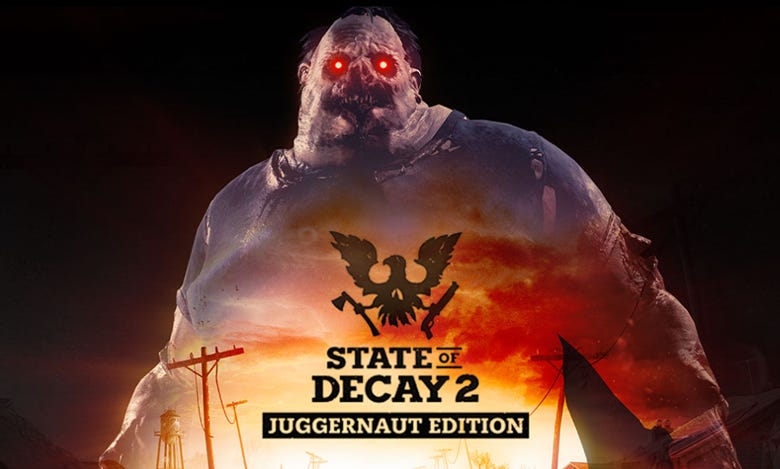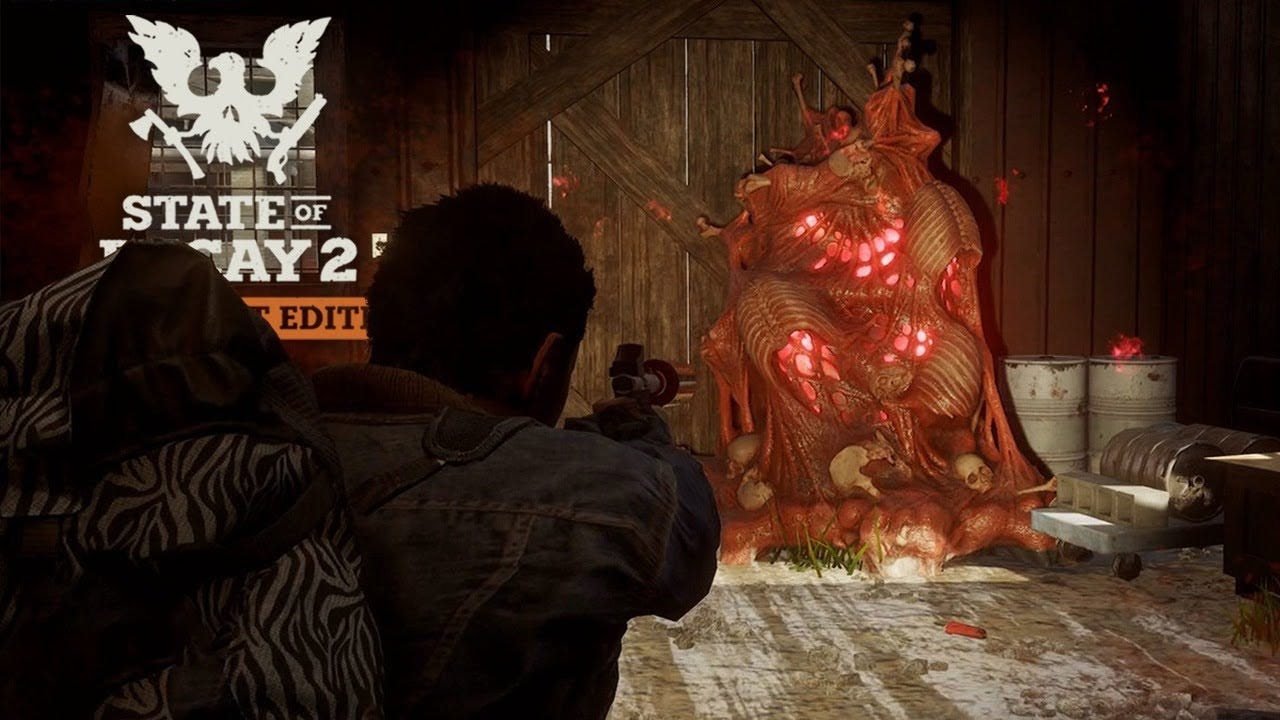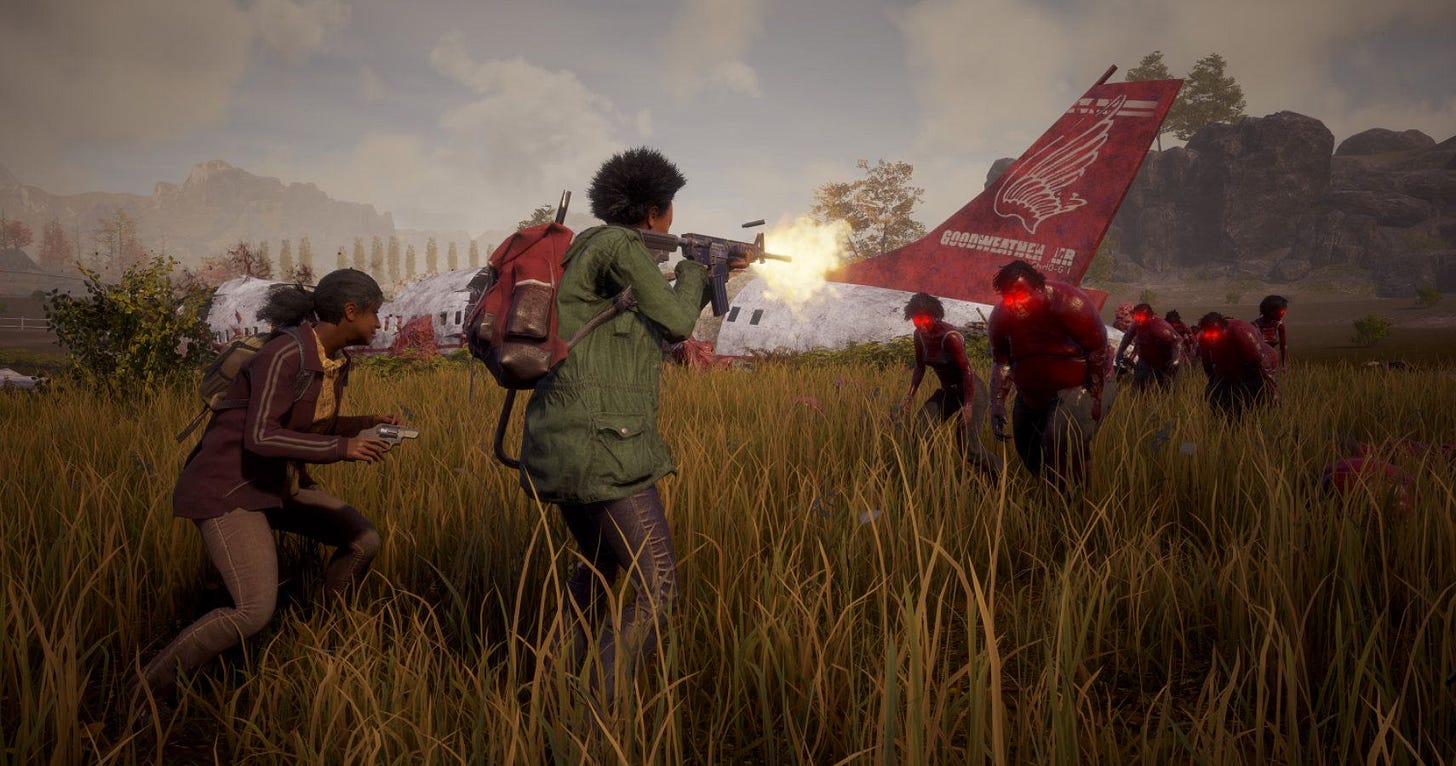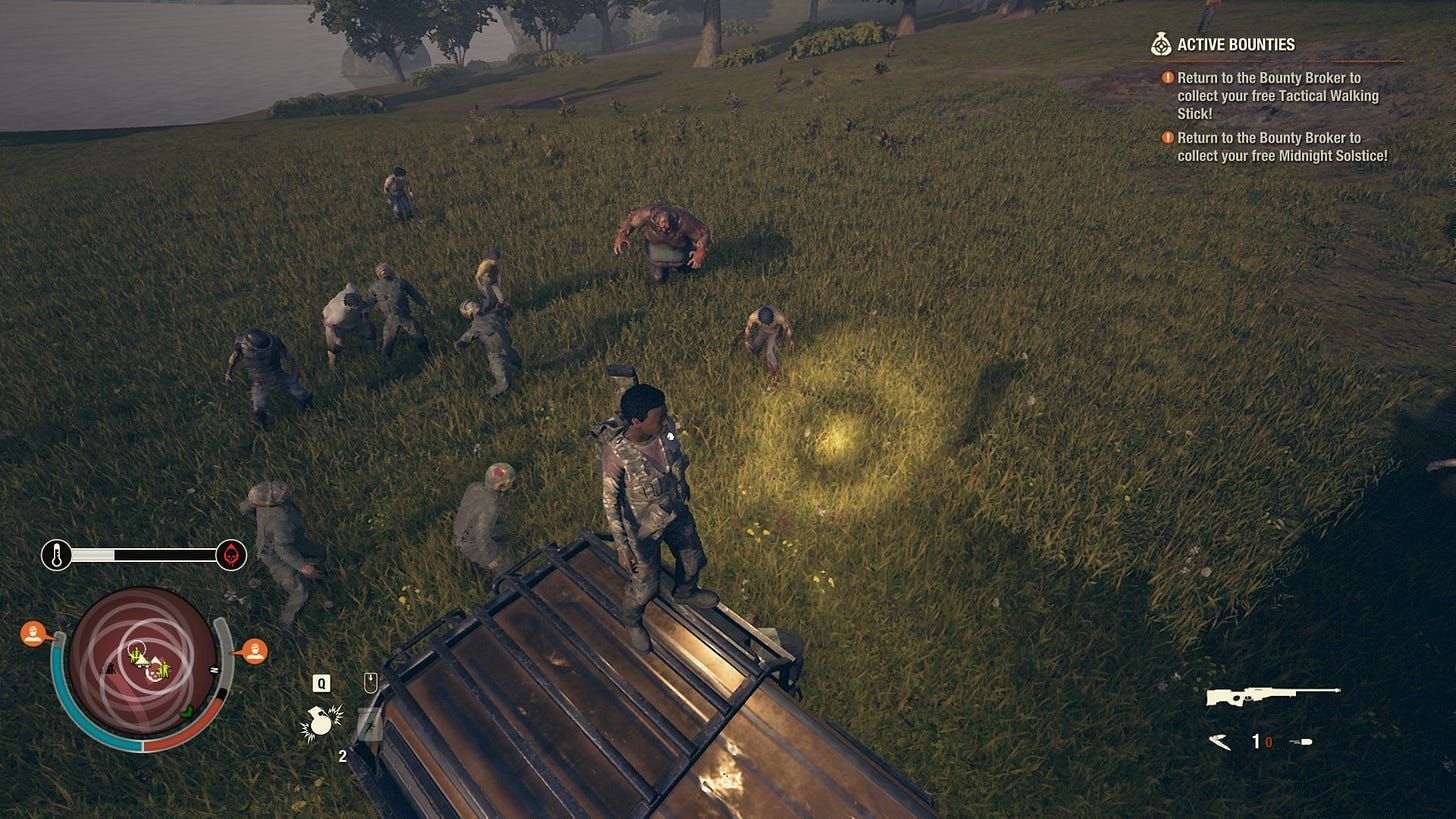State of Decay 2 and Standing on Car Roofs
How seemingly small and cheesy mechanics can massively enrich a game
An Introduction
Hey, everyone! This is Dissecting Game Design, a publication where I discuss videogames and attempt to focus on specific game design aspects I find interesting and worth discussing. I am not an expert on game design by any means, so take my opinion as just that - an opinion. This is by no means a review. Even if it were, I think reviews should be about engaging with art through different perspectives instead of attempting to assign a concrete value on it. Please approach this as a discussion in which I try to figure out why I think something works (or doesn’t work) from my subjective game design perspective.
State of Decay 2 - An amazing zombie game
State of Decay 2 is an action-adventure zombie game that has survival and base management elements. At its core, the game is designed around the question of what a community of survivors would have to do to set up a more permanent base during a zombie apocalypse - lots of running around and looting buildings for supplies, applying different kinds of knowledge to build useful facilities, contacting other survivor groups, and doing your best to make a self-sustaining base. While the game is not exactly realistic, it doesn’t have to be, since most of the design elements are justified within the bounds of game logic.

The gameplay loop is very engaging and addictive - you venture out of the safe space your base provides in search of supplies and other useful equipment, you haul all of it back to your base, and do it again and again. With each subsequent looting run, more and more places of interest will become empty, forcing you to go farther away into even more dangerous places. The equipment and supplies you gather will help you survive this organic increase in difficulty.
In what I consider an interesting design choice, State of Decay 2 offers a mixture between open-ended gameplay and objective-oriented progression. The game is structured around the destruction of all-infecting masses called Plague Hearts. The map is littered with spots controlled by these entities, and the player’s ultimate goal in any one playthrough is to find and defeat all of them.

The Plague Hearts have a couple of effects. Firstly, they turn regular zombies within their area of control into blood zombies, making them much more dangerous by allowing them to inflict the Blood Plague status. This is essentially a second sort of health bar, much like Darkest Dungeon’s stress bar. While regular zombies can only kill you by emptying your health, blood zombies will give you a certain amount of blood plague on top of the normal health damage they deal. When you are completely infected by blood plague, your survivor essentially becomes marked for death. The game will give you a short amount of time to get them back to base to administer the cure. If you fail to do so, the character will die, regardless of how much health they have left. This is made even worse because Blood Plague also bestows a pretty devastating debuff, making your survivor noticeably weaker in combat.
Secondly, Plague Hearts will make any building within their reach uninhabitable. Usually, you can set up an outpost in a place of interest, which will give you a small safe zone and other varied bonuses based on what the building actually is. Some will give you resource income, others can provide your base with water or power, and some can even give you the ability to deploy artillery strikes. Having outposts is crucial. Not only do they play a vital role in your resource economy, they also allow you to loot more effectively, since they also allow you to deposit items back into your base. Well, none of that can be done if the building is close enough to a Plague Heart, so looting in infected areas is considerably more dangerous.

These mechanics - the Plague Hearts and the looting runs - create a very natural feeling of purpose and progression. You’re heavily incentivized to defeat Plague Hearts because it provides very tangible and useful benefits other than just allowing you to complete the game. Areas become much safer to loot when you destroy a nearby Plague Heart, allowing the main gameplay loop to be handled more effectively. Additionally, you also get a substantial and valuable loot drop!
Attacking a Plague Heart feels, essentially, like a boss fight. The hearts are pretty durable, and will summon tons of plague zombies throughout a fight. They also have a very lethal attack that they can do twice whenever they hit a certain amount of health points. They’ll exude a poisonous gas that will reduce your character’s total health and stamina until they have sufficient rest at base. Thankfully, this attack is very easy to avoid, but it is long lasting and often forces you to run away for a bit. This mechanic makes it so that you can’t just blitz a Plague Heart - you have to engage with the blood zombies that spawn, as well as any special zombies that might be attracted to the fight.
Well, as long as you’re attacking the Plague Hearts in melee, that is.
The Car Roof in the room
Fighting Plague Hearts is exhilarating. As you land your first attack on the tumorous mass, the combat music kicks in, and you start to hear dozens of zombie growls around you. There’s a rush of adrenaline, and a feeling of danger as you feel as if something’s just behind your back. You have to weave in and out of zombie hordes, forcing you to find a balance between dealing with the more immediate threat of being bitten and attacking the source of all of it. In the highest difficulty, the Heart will even spawn Blood Ferals, arguably the most dangerous type of special zombie, to defend itself from the player. Simply put, Plague Hearts are very engaging as an activity, and are very well designed to test not only the player’s combat skills, but the resources they’ve collected up to that point.

There are multiple valid ways of dealing with Plague Hearts. Melee is the most fun. Within Melee weapons, Heavy Weapons are the most effective. There’s nothing like whacking the screeching horror with a giant sledgehammer, watching as some unfortunate zombie walks into your swing and promptly goes flying across the room. You can also use explosives, where C4s will absolutely destroy the encounter, balanced by being exceedingly rare unless you have two very high level and specific skills that allow you to craft them for a high cost. You could also shoot the Plague Hearts, where high caliber, high damage weapons will obviously be your best friend. However, ammo for these tends to be quite rare (unless you have certain facilities built), so you don’t always have this option open to you.
Despite the myriad of ways you can destroy a Plague Heart, most experienced players will agree that cars, one of the most common and useful things in this game, will be your best friends during these encounters (and most dangerous situations in general). Not only do they give you trunk space to allow you to carry more on your looting runs, not only do they allow you to travel faster, not only do they allow you to escape pretty much any situation by driving backwards into a horde of zombies - they have the absolutely invaluable ability to give you a bit of high ground while on foot that’s inaccessible to zombies.
That’s right - the fact that you can stand on top of a car’s roof is one of the most useful things in this game. Height, in general, is an amazing advantage. Any building that has a ladder gives you an instant safe zone. No zombie can chase you up a ladder, and you can just stay up there for as long as you’d like. Having this sort of safety be easily accessible on a moving object that you’ll also want to have for multiple reasons is, at worst, extremely useful, and, at best, extremely broken.
For Plague Hearts, this means that you can strategically park your car and have a completely safe spot while destroying it. You could run in, attack the Heart in melee, and retreat to your car once it uses its gas attack. Alternatively, you could park near a window with a clear line of sight to the Heart, and shoot it with a gun, provided you have the ammo to do so. This is made even stronger in every difficulty except the last one, since destroying a Heart will instantly kill any plague zombie around its area. This means that once you shoot it enough, you will effectively deal with every threat at the same time.

In general, you could argue that being able to stand on top of cars gives you a pretty safe way of not engaging with the game’s challenges. I had a lot more fun before I realized this. The hectic and climactic battles left me feeling a sense of excitement and tension, as I used every last resource at my disposal to finally bring down the disease-ridden monstrosity. Once I realized I could use my car, well, I didn’t have to deal as much with a large chunk of the game’s challenge.
But, is this really a problem?
Even though I had more fun when I had to risk my life and get my hands bloody to kill a Plague Heart, I honestly don’t think this is an issue.
For starters, it feels like the folks at Undead Labs planned for this to be a feature. The fact that high ground is this safe is no oversight. Scattered throughout the map, you’ll find tons of barns with ladders and clear line of sight to the ground below. You’ll also find tall containers you can climb, but zombies can’t. Even some pieces of rubble can be used to obtain the safety of high ground.
However, this safety isn’t absolute, and it’s also heavily conditional. At some point, you’ll have to go down (unless you exit the game or something). And then, you’ll have to deal with what you were escaping. When zombies can’t reach you, but know of your presence, they’ll start screeching loudly, often attracting even more zombies to surround you.
The best part of this is that it absolutely works from a setting and lore perspective. When I was younger and used to be fearful of zombies, I used to think that, if zombies were ever to invade my house, I’d climb up to the attic because they wouldn’t be able to reach me. And even if they did, all I’d have to do was knock them right off the ladder by kicking them or hitting them with something. However, I knew even then that that would probably be nothing more than a temporary stopgap to keep my life for a little longer. At the end of the day I’d still have to go down to eat or do any other number of things I’d have to do to survive.
It feels like this is exactly what high ground is in State of Decay 2 - a stopgap. Sure, you can climb onto your car or up a ladder. But at some point, you’ll have to go down to do one of the many things you need to do. And then, the zombies will still be there, probably more numerous than before. When you’re hiding in this temporary safety, the cacophony of guttural screeches feels horrifying, reminding you that even though it might seem so, you’re not really safe - you’re just trapped.
Add on top of this the existence of another member of the special zombies’ roster - the Juggernaut. These hulking creatures are kind of slow, but make up for it by being absolute tanks that can dish out a ton of damage. Crucially to this issue, they also have the ability to knock cars around. See where this is going?
If you’re in the middle of fighting a Plague Heart and are relying on the safety of your car’s roof, a Juggernaut is the most terrifying thing you can see. If you stay put, it will undoubtedly come and knock your car to the side, consequently throwing you to the ground and probably into the arms and teeth of many bloodthirsty zombies.
Put these two aspects together and it seems clear that State of Decay 2 acknowledges the usefulness of high ground, and gives it to you knowingly and willingly. It offers a very temporary and highly conditional form of safety that it can also take away just as easily. It allows you to do something that most of us would probably at least think about doing in that situation, and shows you how it probably wouldn’t work as well as you think it would.
Cheese isn’t always bad
“Cheese” is something I’m very interested in in games. Someday I’ll write a bit more about it. It basically refers to ways of beating a game’s challenge in unintended and “underhanded” ways. Some people hate it, others like it, and probably most don’t mind. Personally, I don’t think there’s anything wrong with it. Everyone can play in any way they find the most fun. If I think something is too cheesy in a way that robs me of enjoyment, then I’ll try my best not to do it.
As developers, however, I think it’s important to give it some thought. We craft a world very deliberately, and we often have a very specific vision for what we want the player to experience. It’s important that we consider very carefully whether a possible strategy will interfere with our vision, and allow our players to optimize the fun out of our games.
While definitely cheesy, I don’t think this is what the case of the car’s roof does. It seems like State of Decay 2 is fine with giving us this sense of safety, so long as we understand it is only temporary and ultimately fixes nothing. Additionally, I think it compounds wonderfully with the setting of the game, which is a great example of allowing your mechanics to be dictated by lore.
If something feels cheesy to you as a developer, cutting it outright might not be the best choice. Sometimes, it’s worth seriously considering whether it’s even a problem in the first place. And, if it is, there’s often more ways of handling it than just completely preventing the player from doing it. We have to be very mindful of what feels fun for players, as well as what makes sense to them. While it’s good to stick to our vision, it’s also good to question whether sticking to that vision so strictly is harming or benefiting our game. Personally, I think State of Decay 2 would be a worse game (however slightly) if I couldn’t experience my daydreams as a fearful teenager in the way I could thanks to this game - and I think that’s a wonderful thing.





This is some classic Dissecting Game Design Content